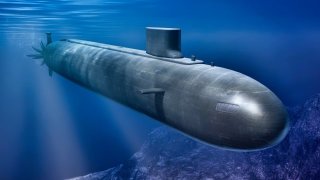Why Doesn't the U.S. Navy Build Diesel Submarines?
Since the USS Nautilus (SSN-571) entered service in 1954, nuclear power has essentially defined the U.S. Navy's undersea dominance. Nuclear power simply offers performance advantages over conventional, diesel-electric submarines.
During her thirty-one years in service with the U.S. Navy, the USS Blueback (SS-581) participated in Pacific Fleet operations, which included a transiting of the Panama Canal. In September 1961, she also set a record by traveling 5,340 miles from Yokosuka, Japan to San Diego entirely submerged.
The submarine also earned two battle stars for her service in the Vietnam War.
This might not seem all that remarkable, but the Barbel-class USS Blueback accomplished that feat as a diesel-powered submarine, not a nuclear-powered boat!
The Last U.S. Navy Diesel Sub
Laid down by Ingalls Shipbuilding Corporation of Pascagoula, Mississippi in April 1957 and launched in May 1959, USS Blueback was the last non-nuclear submarine to enter service in the U.S. Navy. Serving until October 1990, she was also the final conventionally powered combat-capable submarine to be decommissioned.
The submarine was also quite advanced, in that it incorporated numerous, even radical engineering improvements over the previous diesel-electric subs, including being the first to be built with the "teardrop-shaped" hull that had been tested on the USS Albacore (AGSS-569), as well as the first to feature a single propeller.
The hull design was critical in that it increased underwater speed dramatically while it also enabled the submarine to be far more maneuverable. Additionally, the Barbel-class utilized a combined control room, attack center, and conning tower in the same space in the hull.
SS-581 is the only one of the three Barbel-class boats built to be maintained as a museum ship.
Nuclear-Only Submarine Force
Since the USS Nautilus (SSN-571) entered service in 1954, nuclear power has essentially defined the U.S. Navy's undersea dominance. Nuclear power simply offers performance advantages over conventional, diesel-electric submarines.
As Ensigns Michael Walker and Austin Krusz, U.S. Navy, wrote for the U.S. Naval Institute in June 2018, "The mission capabilities that the Navy asks of its submarine force are demanding. Because the United States has oceans on either border, having a strong submarine force is important not only in coastal defense, but also for protecting major sea lanes by controlling the open ocean. Nuclear attack submarines exercise sea control to support surface strike groups, shadow ballistic-missile submarines, and deny enemy ships access to areas of interest."
They further noted that the submarines are part of the "blue water" force, able to operate throughout the world. Nuclear power enables a submarine to meet that requirement, as it allows for nearly unlimited endurance, with the nuclear reactor never needing to be refueled in a 25-year lifespan.
"This means that a U.S. submarine's limitations are only consumables, such as food," the authors added.
A nuclear reactor allows the submarine to operate at a high speed for a long period, whereas diesel submarines operate using electric batteries and can only remain submerged for a few days at slow speed, or a few hours at top speed.
Diesel-electric submarines must snorkel frequently to clear the exhaust from running the diesel generators to charge the batteries.
What About AIP Subs?
The counterargument is that some nations have developed air-independent propulsion (AIP) submarines – notably Sweden's Gotland-class submarines, which were built at the Kockums shipyard in the 1990s and the first to feature a Stirling engine AIP system. That allowed the boats to extend their time underwater endurance from a few days to weeks, a capability that had previously only been available with nuclear-powered submarines.
The technology has since been incorporated into numerous Japanese and Chinese submarines, while Germany and France have developed a fuel-cell and steam turbine system based on AIP.
AIP-powered submarines cost far less than nuclear-powered submarines, but they remain deadly quiet while cruising underwater at low speeds, even for weeks at a time. The technology was so successful that when the United States Navy was able to lease the HMS Gotland (A-19) for use in anti-submarine war games in 2004 it was able to "sink" the USS Ronald Reagan, the then-newly constructed $6.2 billion aircraft carrier!
The outcome was replicated multiple times and the stealthy Swedish sub was able to "run rings" against an American carrier task force.
Nuclear is Costly
Though Ensigns Walker and Krusz made a good argument for nuclear-powered submarine advantages, they actually wrote that aforementioned piece to make a case for diesel submarines – and noted several key points that suggest the U.S. Navy should consider diesel-electric boats.
"Such a high cost for a nuclear-powered fleet makes it impossible to keep pace with near-peer competitors in producing large numbers of capable submarines. Currently, Russia and China have large numbers of ingoing submarines, and the United States must keep up with both peer competitors. The U.S. industrial base is maxed out at building two Virginia-class fast attack submarines per year," Walker and Krusz wrote – and that situation has only gotten worse in the five and half years since they published their paper.
They further warned that diesel-electric technology has continued to catch up in terms of offering many of the capabilities offered by nuclear power. Moreover, diesel submarines could be built faster, which could allow the U.S. Navy's submarine force to expand – rather than shrink in size.
Nuclear Disposal
It may not just be conventionally-powered submarines that the U.S. Navy should reconsider as its primary focus. Currently, all 11 of its supercarriers are nuclear-powered, which requires expensive and time-consuming mid-life complex overhaul and refueling.
But it will be an even more costly and time-consuming endeavor to dispose of its retired nuclear-powered carriers.
While the U.S. Navy sold its last two conventionally-powered carriers for a penny each, it will have to pay for the recycling of USS Enterprise (CVN-65), the world’s first nuclear-powered aircraft carrier that was retired after more than five decades in service in 2012.
It won't be either a cheap or quick process.
As of last year, it was estimated that dismantling the carrier could take at least five years and cost between $554 and $696 million at a commercial yard. Another plan called for the dismantling to take upwards of 15 years and cost as much as $1.358 billion.
One issue is that U.S. Navy shipyards are overworked, and can't adequately address the maintenance for active warships – and there simply isn't the capacity to take old nuclear-powered carriers apart.
Nuclear-powered submarines have proven easier – but by no means "easy" – to dispose of, but building them is becoming increasingly more complicated.
The USS Columbia (SSBN-826) has been touted as one of the most advanced submarines to date. But it will take a significant amount of time to build those boats, maintain the current fleet, and dispose of the retiring nuclear-powered subs. Currently, U.S. shipyards can deliver just 1.2 attack subs a year, while they are still only on a path to reach two Virginia-class boats annually by 2028.
Perhaps, Ensigns Walker and Krusz need to be heard. Is it time for the U.S. Navy to reconsider diesel-electric AIP submarines?
Author Experience and Expertise
Peter Suciu is a Michigan-based writer. He has contributed to more than four dozen magazines, newspapers, and websites with over 3,200 published pieces over a twenty-year career in journalism. He regularly writes about military hardware, firearms history, cybersecurity, politics, and international affairs. Peter is also a Contributing Writer for Forbes and Clearance Jobs. You can follow him on Twitter: @PeterSuciu.


